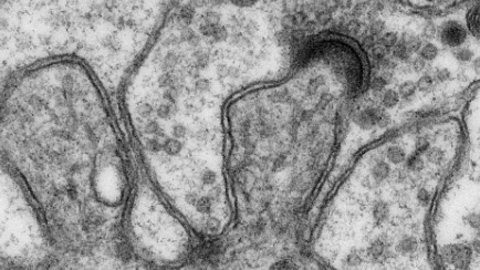Zebrafish synapse proteome characterised
Researchers from the IIB Sant Pau, the UAB and University of Edinburgh present the first characterisation of proteins expressed in the synapses, or neuronal connections, of the zebrafish, an animal model for the study of the human brain and its pathologies.

Brain synapses are the points of communication and transmission of information between neurons. They therefore determine the organisation of neural circuits, essential to the global performance of the central nervous system. In recent years a large number of genetic studies have identified mutations in genes expressing themselves in synapses involved in neurological diseases and, especially, in psychiatric disorders such as autism, schizophrenia and intellectual disorders. These studies have established synapses as a critical structure in many diseases of the brain, and this has given way to the concept of synaptopathies.
The zebrafish, or Danio rerio is an animal model widely used in the study of the nervous system and its diseases, since it shares many similarities with the human brain. This species is also used in the development of new drugs for the treatment of brain disorders, for which in the majority of cases there are no truly effective therapies.
The research team, directed by Àlex Bayés from the Molecular Physiology of the Synapse Lab of IIB Sant Pau and associated with the UAB, presented the first study on the synapse proteome of the zebrafish in the latest edition of Nature Communications. The study represents an essential tool for future research in which this model is used to characterise the pathophysiology of synaptopathologies, as well as in the development of drugs aimed at treating these disorders.
This first characterisation of the synapse proteome of an inferior vertebrate has also allowed to study their evolution compared to that of mammals. The analysis shows how the evolution of vertebrates has favoured an increased complexity in synapse proteomes. An observation which researchers qualify as unexpected and highly interesting. “Having more synaptic proteins has led to an increase in the number of molecular processes produced, as well as to the diversity in the types of synapses. Given that the synapse is the brain's basic cognitive unit, the expansion of its components could have contributed to the diversity of behaviours and intellectual capacities of vertebrates", Dr Àlex Bayés concludes.
IIB Sant Pau
The mission of the Sant Pau Biomedical Research Institute (IIB Sant Pau) is to improve the health and quality of life of people through the production and dissemination of scientific knowledge, and the generation of innovation in health care and its application in clinical practices and health care policies. With these objectives, and as a member of the healthcare centres with the seal of approval from the Institute of Health Carlos III, the Research Institute of the Sant Pau Hospital, a UAB-affiliated centre, together with 9 more centres, have come together to create a top level research institute geared towards developing new techniques and processes which permit improving the quality of life of individuals.
The IIB-Sant Pau includes seven areas of research and has more than 50 research groups. It has published over 2,800 articles the most influential scientific journals and, thanks to its scientific excellence, in 2016 it renewed its certification as a Health Research Institute for five more years, and also received the Human Resource Excellence in Research quality seal from the European Commission.
The mission of the Sant Pau Biomedical Research Institute (IIB Sant Pau) is to improve the health and quality of life of people through the production and dissemination of scientific knowledge, and the generation of innovation in health care and its application in clinical practices and health care policies. With these objectives, and as a member of the healthcare centres with the seal of approval from the Institute of Health Carlos III, the Research Institute of the Sant Pau Hospital, a UAB-affiliated centre, together with 9 more centres, have come together to create a top level research institute geared towards developing new techniques and processes which permit improving the quality of life of individuals.
The IIB-Sant Pau includes seven areas of research and has more than 50 research groups. It has published over 2,800 articles the most influential scientific journals and, thanks to its scientific excellence, in 2016 it renewed its certification as a Health Research Institute for five more years, and also received the Human Resource Excellence in Research quality seal from the European Commission.